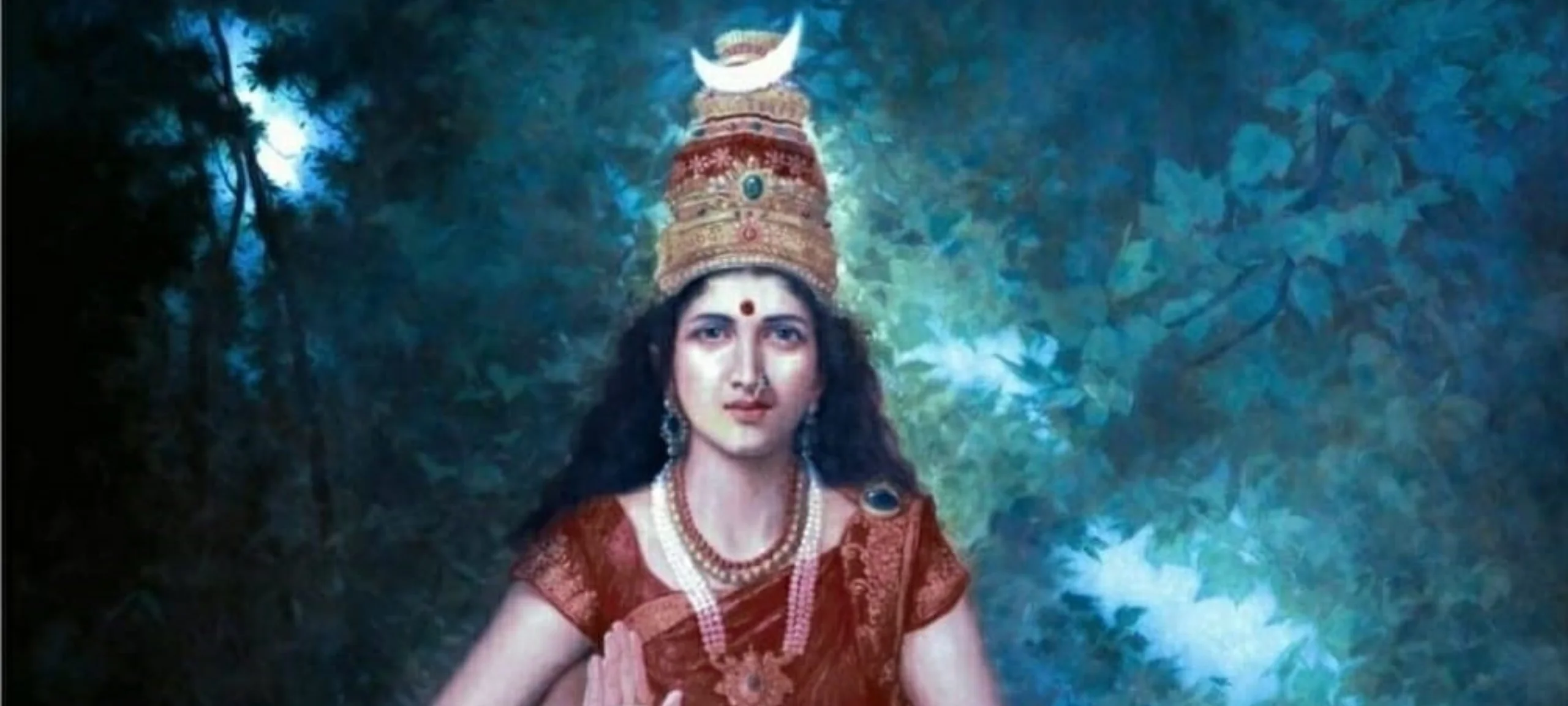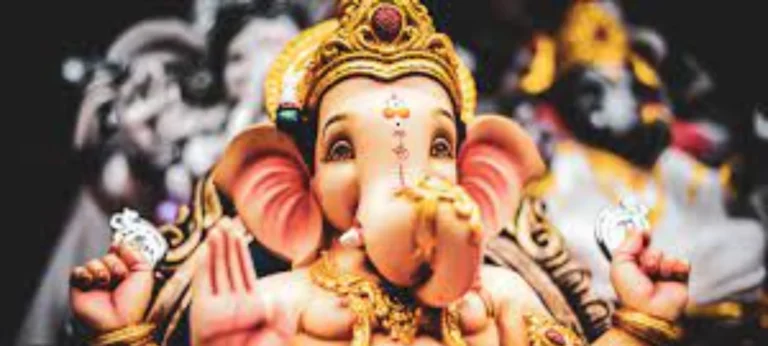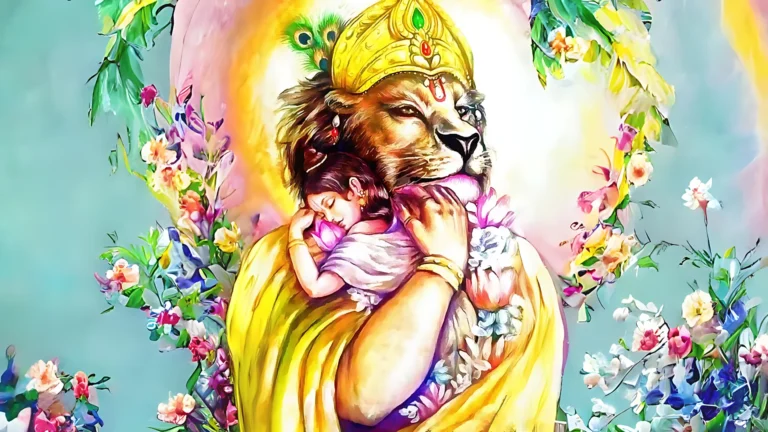Please Like the Blog and Share it for Maximum Reach
Table of Contents
Devi Adi Parashakti
Mahashakti is the source of the entire manifestation. The three divinities Brahma, Vishnu, Shiva including all other Devatas have all emerged from her body.
She is Tripura Parameshwari, the queen of the entire cosmic creation. This is the conviction of the followers of Shakta Sampradaya. The Shakta Sampradaya is a widespread cult in the country.
Shakti can be worshipped in three modes-
In the Satvik, Rajasik and Tamasik modes. Based on each mode you have three different Shakta Sampradayas namely-
1) Dakshinachara
2) Veerachara
3) Vamachara.
Out of these, the Veerachari and Vamachari Sampradayas hide from the common public.
Since, their procedure of worship is detested by the common people and is quite opposed to the laws of the nation they live in concealment.
Furthermore, the human sacrifice tradition of the Veerachar sect has been long since abolished.
Creation, maintenance and destruction
Aadhya Shakti assumes 3 forms for the purpose of creation, maintenance and annihilation. She becomes goddess Sarasvati form for creation, Lakshmi for sustenance while Mahakali for annihilation.
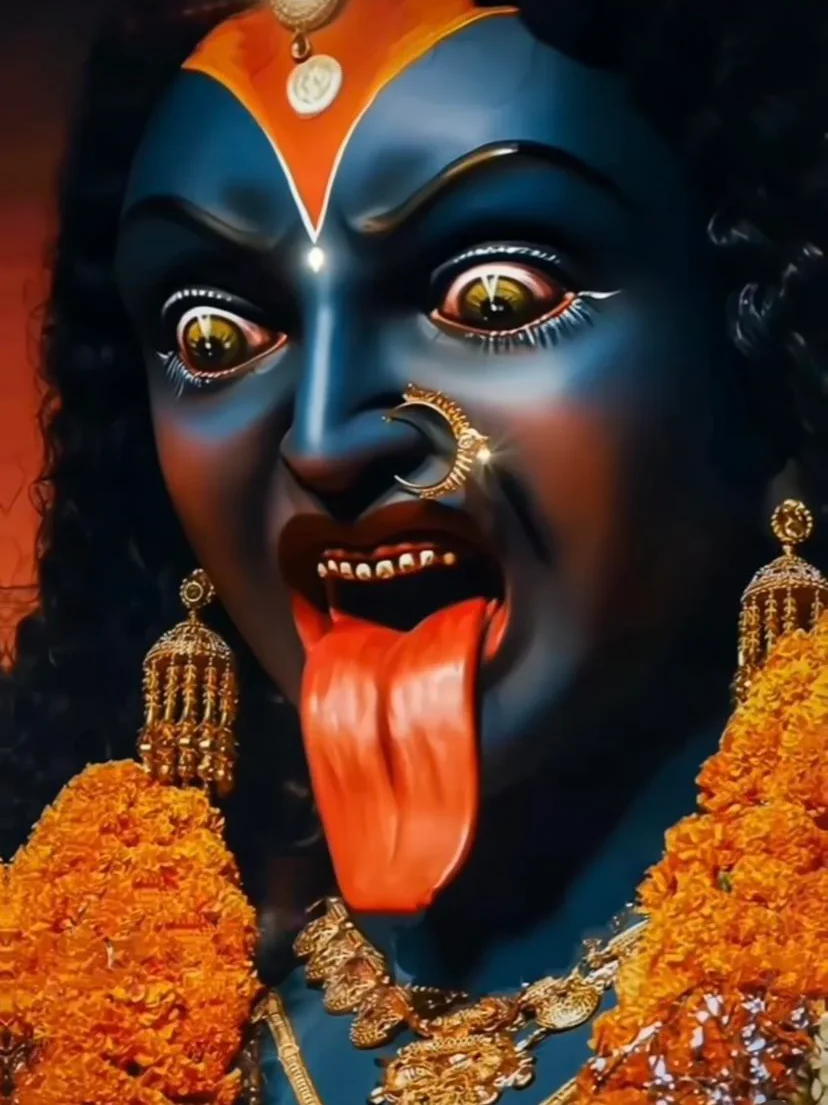
It is essential to know that these forms of Sarasvati, Lakshmi and Mahakali are different from the consorts of Brahma, Vishnu and Shiva. Besides, the Durga Saptashi explains the procedure of meditating on these three forms-
- Mahasarasvati- She rides a lion and has 8 arms
- Mahalakshmi- She rides a lion and has 18 arms
- Mahakali- She has 10 heads and 10 feet
10 Mahavidya and 9 Durga
Mahashakti has taken the form of 10 Mahavidyas and Navadurga.
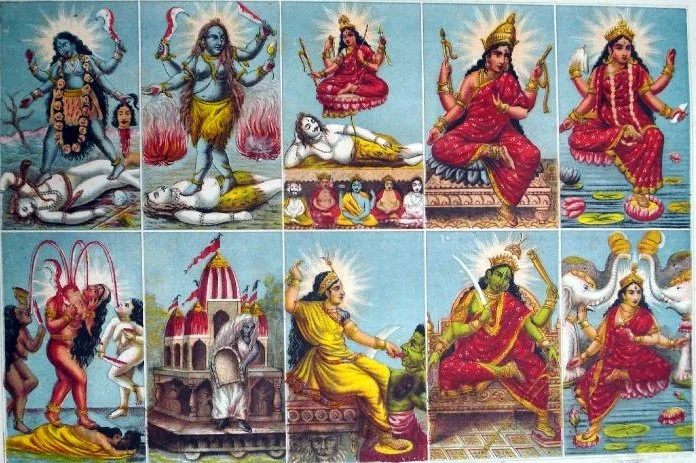
Now, the 10 Mahavidyas of Mahashakti are-
1) Kali (काली)
2) Tara (तारा)
3) Shodashi (षोडशी)
4) Bhuvaneshwari (भुवनेश्वरी)
5) Bhairavi (भैरवी)
6)Chinnamasta (छिन्नमस्ता)
7) Dhumavati (धूमावती)
8) Bagala (बगला)
9) Matangi (मातङ्गी)
10) Kamala (कमला)
9 Forms of Durga (Navadurga)
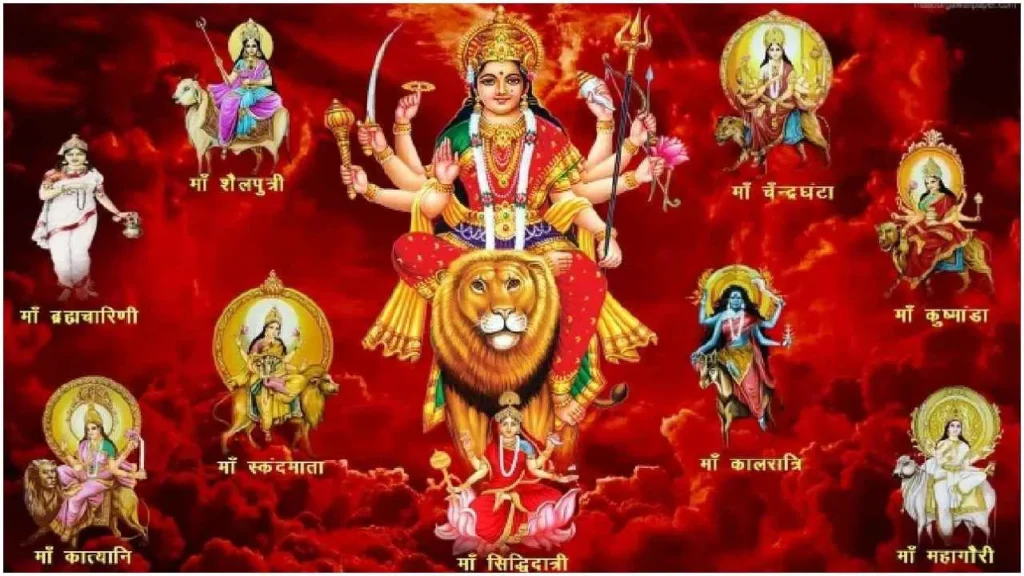
The Navadurgas are
1) Shaila putri (शैलपुत्री)
2) Brahmacharini (ब्रह्मचारिणी)
3) Chandraghanta (चन्द्रघण्टा)
4) Kushmanda (कुष्माण्डा)
5) Skandamata (स्कन्दमाता)
6) Katyayani (कात्यायनी)
7) Kalaratri (कालरात्रि)
8) Mahagauri (महागौरी)
9) Siddhidatri (सिद्धिदात्री)
Nature of Shakti
Shakti, the supreme authority, incarnates in three modes of nature, Sattva, Rajas and Tamas for Creation, maintenance and annihilation respectively.
Out of these forms the one at the level of Brahman, Shveta Varna (श्वेत वर्ना) represents Sattva, Rakta-Varna (रक्त-वर्णा) represents Rajas while Krishna varna (कृष्ण-वर्ना) is for Tamas.
Lord Shiva is the soil while Shakti is the seed. Hence, their union gives rise to the Nada (Cosmic sound). Through this Nada, the Trishakti emerge.
The Trishaktis are-
1) Iccha shakti (The ability to desire)
2) Kriya shakti (The ability to act)
3) Jnana shakti- (The ability to derive knowledge).
9 forms of Shakti
Besides, Shakti has 9 forms in this universe. They are-
1) Vaishnavi (वैष्णवी)
2) Brahmani (ब्रह्माणी)
3) Raudri (रौद्री)
4) Maheshwari (माहेश्वरी)
5) Narasimhi (नारसिंही)
6) Varahi (वाराही)
7) Indrani (इन्द्राणी)
8) Kartiki (कार्तिकी)
9) Sarvamangala सर्वमंगला (भैरवी)
There are 50 Vishnu Shaktis. However, the Vaishnavas consider three primary Shaktis of Lord Vishnu.
They are-
1) Samvit (संवित)
2) Samdhini (संधिनी)
3) Hladini (हलाधिनी)
Even Lord Shiva has 50 Shaktis. They are called Rudra Shakti.
Test your Alignment with the Spiritual Subject Matter (only 7 Questions)
The scores generated in this Quiz are relative. There are no right or wrong answers. A percentage towards 100 indicates that you are more aligned to the overall subject matter.
Stories of Devi Adi Parashakti:
Story of Sati
The two Lords, Brahma and Vishnu had accepted their consorts. But Lord Shiva was absorbed in penance. He had to yet accept the life of a householder for the creation process to commence. However, there was no woman who could attract Lord Shiva.
So Lord Brahma venerated Adi Shakti and also convinced Daksha to do so.
After a long span of a thousand years, Mahashakti was pleased. She agreed to be the daughter of Daksha. Thus she was born as Daksha Kanya Sati.
During Daksha’s fire sacrifice, when Sati Devi witnessed the humiliation of her husband, Lord Shiva, and saw that her father had not kept a share of sacrificial offering for her Lord since he was a Kapali (one who seeks alms), she flung herself into the sacrificial fire.

Lord Shiva, feeling pangs of separation from his consort, hung her body on his shoulders and wandered in the different lokas.
Eventually, Brahma, Vishnu and Shani dev intervened by dividing the body of Sati Devi into small fragments and dropping them on earth. The sites where these divine fragments fell came to be known as Shaktipeeth.
You will also find many Shakti Peeths in Bharat. In fact, Lord Shiva resides in each abode bearing different forms.
Reincarnation of Sati
Thereafter, Sati Devi reincarnated as the daughter of Himavan and Menaka. She was born on the auspicious day of Navami during the spring season.
Her father christened her Kali. However, since she was Parvat Putri (The daughter of a mountain) she came to be known as Parvati. Eventually, on the guidance of Narad muni, Parvati performed severe penance and procured Lord Shiva as her husband.
Devi Parvati’s absence
One day, in mount Kailash, Lord Shiva made a humorous comment on Devi Parvati’s dark complexion. Upset at such a remark she hid herself for a few days. Then, she performed severe penance in Mount Himalayas and became fair.
Shakti kills Mahishasura
Mahishasura had obtained a boon that no male could kill him. As a result, he had defeated the Devatas. Now, the Devas approached Brahma for advice.
Even Lord Vishnu and Shiva had assembled there. Instantly, their Shakti detached from their bodies as a glow and assumed a majestic female form. She was Bhagavati Lakshmi, the bearer of 18 arms.

In this regard, the Devi Bhagavat elaborately explains how each part of her body was formed, the names of their respective lords and so on.
Some sources say that Mahishamardini bore 18 arms while others even speak of a thousand arms owing to differences in kalpa. Devi assumed the Ugrachandi form with 18 arms at the beginning of Creation, the 16-armed Bhadrakali form in the second kalpa and the 10-armed Durga form in the present kalpa.
Thus, she killed the demon Mahishasura. In all the three forms you will notice an idol of Mahishasura lying under her feet. This is a result of Devi’s boon to Mahishasura.
Goddess Durga
Durg,the son of demon Ruruka had grown immortal by the fruit of his penance. So at the request of the Devatas, Lord Shiva sent Devi to kill him.
In turn, Devi sent Kalaratri to get a hold on the Asura. The Asura was enchanted by Kalaratri’s beauty and he ran to hold her. However, Kalaratri killed all his associates and reported back to devi.
Finally, the Asura confronted the thousand- armed Mahashakti in the Vindhya Mountains while pursuing Kalratri and died in battle with her. Hence, she is known as Durga since she killed the demon Durg.
Killing of Shumbha and Nishumbha
Traumatized by Shumbha and Nishumbha, all the Devatas started glorifying Mahashakti. Once, Parvati devi enquired- “Who are these Devatas calling?
Immediately, a divine devi emerged from her body and said-
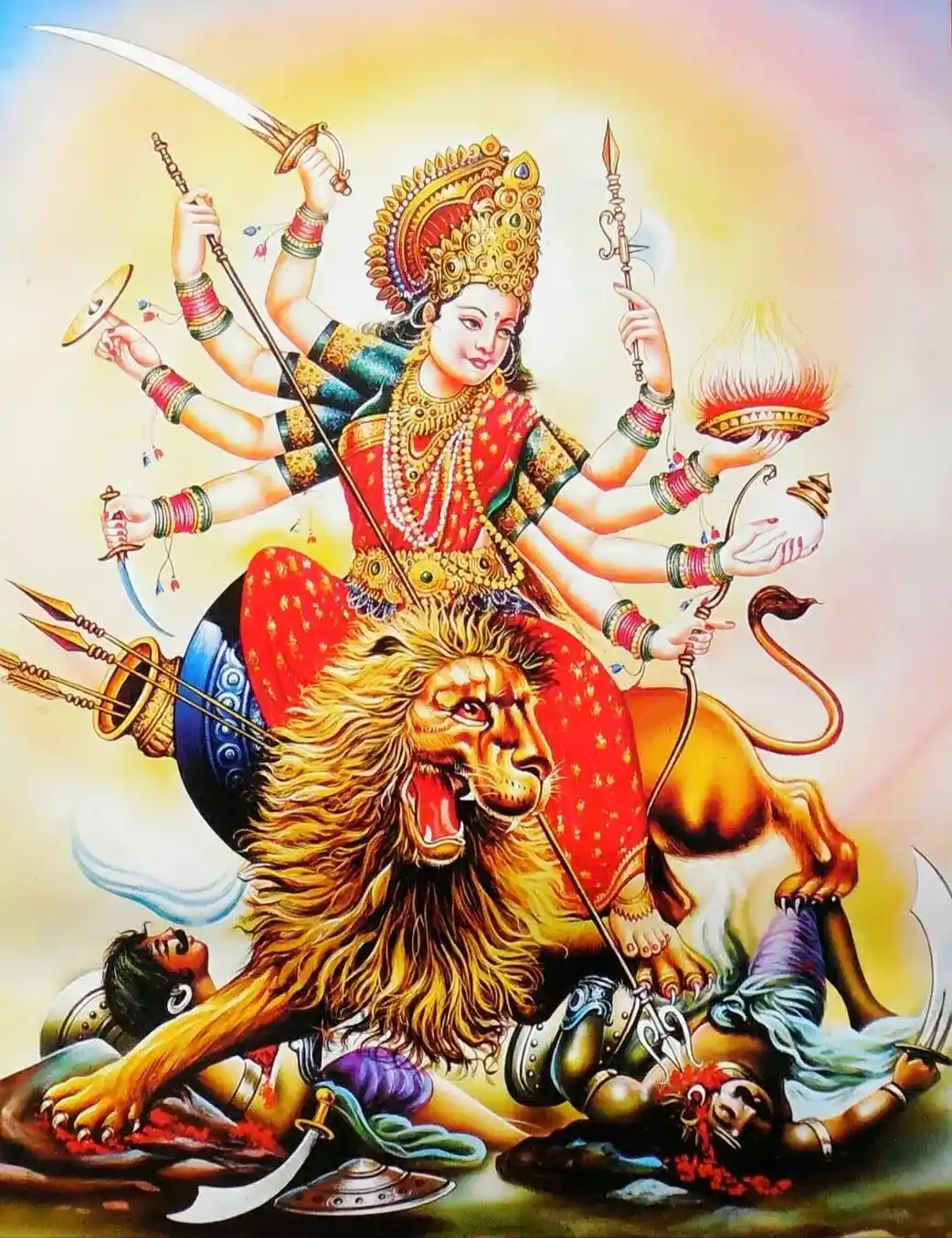
“These people are calling me.” Since this divine effulgence had emerged from Parvati, she is also known as Kaushitaki. Also, since she had separated from Parvati, the form of Parvati transformed into Kali. Thereafter, the powerful Mahashakti killed the two commanders-in-chief Chanda-Munda along with their kings Shumba-Nishumba.
All the Shaktis of the Devas had during the war, the consorts of all the Devatas merged into Devi’s body and assisted the goddess. They entered the battlefield wielding the weapons, ammunition and vehicles of their husbands.
Also, the Chamunda form emerged from Devi’s body, and licked all the blood out of the demon Raktabeej.
Bhramarambha Shakambhari
This Bhramarambha Shakambhari form of Devi would manifest millions of bees from her body and kill all the demons. This Devi, out of mercy, gave rise to fruits and vegetables thus saving people overcome by severe famine.
Please Like the Blog and Share it for Maximum Reach

